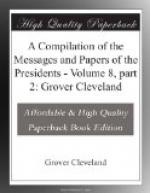The more thorough knowledge acquired through these explorations of the character of the territory which has been relinquished by the United States fully confirms the opinion previously entertained of its little value, either for its timber growth or for purposes of agriculture.
Bordering on the “Big Black” and “Little Black” rivers the growth of pine is large and apparently of good quality, and it is believed that most of the smaller streams falling into the St. John below the “Seven Islands” will be found fringed with pine, but it is quite certain that very little will be found included between the lines of boundary and the highlands as claimed by the United States to the westward of St. Francis River.
The office work of this party is nearly completed, all the calculations arising from the astronomical observations have been made, and the detailed maps (five in number) drawn to the scale of 1:50,000 (or nearly 1-1/4 inches to 1 mile), exhibiting the result of the surveys in 1840, 1841, and 1842, are in such a state of forwardness as to insure their completion by the middle of February.
These explorations and surveys embrace—
1. The highlands as claimed by the United States, extending from the northwesternmost head of the Connecticut River to the portage road which leads from the St. Lawrence River to Lake Temiscouata.
2. The highlands as claimed by Great Britain from the Metjarmette portage to the source of the Aroostook River.
3. All the principal heads or branches of the Connecticut River north of the forty-fifth degree of latitude.
4. The St. John and all its principal branches or tributaries west of the Alleguash River.
III.
The division under the direction of Major Graham has been employed during the past season in making the following surveys, viz:
1. In prolonging the meridian of the monument at the source of the river St. Croix.
2. In making a survey of the Little Madawaska River, a tributary to the Aroostook, from its mouth to its source in the Madawaska Lakes.
3. In surveying the group of lakes lying northwest of the Madawaska Lakes, known by the appellation of the Eagle Lakes, or sometimes by the aboriginal one of the Cheaplawgan Lakes, and especially to ascertain if those lakes, or any of them, emptied their waters into the river St. John by any other outlet than Fish River.
4. A survey of the portion of Fish River included between the outlet of Lake Winthrop and the river St. John.
5. A survey of the river St. John between the Grand Falls and the mouth of the Alleguash.
6. A survey of the Alleguash from its mouth to its source.
7. A survey of the river St. Francis from its mouth to the outlet of Lake St. Francis.
8. In making astronomical observations for the latitude and longitude of the Grand Falls and the mouths of the Grand, the Green, Madawaska, Fish, and St. Francis rivers.




